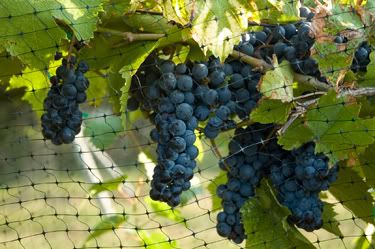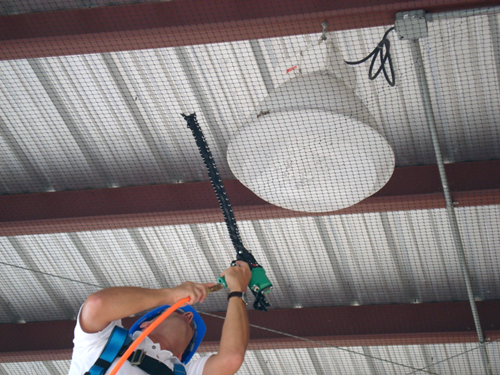by Alex A. Kecskes
When it comes to effective bird control, plastic bird netting is a humane, low-profile pest bird deterrent. It’s designed to physically exclude birds from damaging your home, garden and trees. The netting is easy to use and can be readily cut to size. Most plastic bird netting is sold in two roll sizes: 14 x 100 feet and 14 x 200 feet. It also typically comes in three mesh sizes, depending on the bird species you wish to exclude. There’s a 1/4-inch mesh, a 1/2-inch mesh and a 3/4-inch mesh—to exclude pigeons, sparrows, starlings, swallows and other birds. The best plastic bird netting is made of durable, U.V.-protected polypropylene. This netting comes with a 1-year guarantee. It’s strong, light and virtually invisible. Today’s bird netting is even available in various colors to blend in with your trees, garden or home.There are a number of ways to use plastic bird netting. It all depends on the type of bird and where they’ve become a nuisance. Here are some guidelines to help you from professional bird control experts:To exclude eave-nesting birdsTo prevent pest birds from building nests over your eaves, drape the plastic bird netting at a 45-degree angle over the eave. Use a 1/4- to 1/2-inch mesh size to block out most eave-nesting birds. Make sure you have enough netting to run from the outer edge of the roof to the side of your house. Install the netting using tape, a staple-gun or hooks. Keep the netting taut and don’t leave any gaps for birds to work their way through.To save your small fruit and nut treesTo protect small fruit and nut trees (no more than 8 feet tall), tie bird netting at the bottom to prevent birds from becoming tangled in the netting. Leave a space between the fruit and the netting to keep birds from sitting on the branch and eating your fruit through the holes in the netting. To properly install the netting, measure the circumference of the tree and cut the net to size, leaving at least one foot extra around the circumference. Secure the netting with twine, zip ties or hog rings. One manufacturer offers a bird netting kit for fast, easy installation. The kits include perimeter cable, cable crimps, turnbuckles, intermediate attachments, hog rings, and accessories and tools. To save your bushes, vines and vegetable gardensTo protect your berry bushes, grape vines and vegetable gardens, suspend the plastic netting over these plants by at least 6 inches. This will prevent birds from sitting on the net and eating your fruit through the netting. One effective method of suspending the netting is by using a series of poles planted around the perimeter of the garden area to be protected. To exclude pest birds from your vegetable gardens, wrap each plant or group of plants in netting.
Fire crews recently had to close off a road in Dorset, England as they mounted an 11-man rescue operation. The victim? A pigeon trapped in bird netting above a restaurant.
Improperly installed bird netting has resulted in many birds becoming trapped, injured and killed. All the more reason to use a professional bird netting installer. Companies like Bird-B-Gone, for example, offer a wide range of bird netting solutions. They know that installing bird netting takes special care. For large buildings, like restaurants, bird netting should be installed properly by Authorized Bird Control Installers. These installations often call for hundreds or even thousands of square feet of netting, special boom lifts and power gear. If the netting is improperly installed, it will droop and sag, allowing birds to enter through gaps. Experienced bird netting installers will also be able to choose the right netting for the application. Heavy-duty bird netting comes in 1-1/8- to 2-inch mesh for blocking out gulls, crows and pigeons; and 3/4-inch mesh for keeping out smaller birds like sparrows. Professional netting installers will use high quality bird netting that lasts through many seasons of punishing weather. The best heavy-duty netting is made of high-strength polyethylene. This netting meets ISO 1806 protocols, is UV stabilized, flame resistant and rot- and water-proof. In some cases, even if birds do manage to sneak behind the netting, there are ways to save these birds. Bird•B•Gone, for example, offers a product called Bird-Scape. It lets birds out when they are trapped behind netting. This netting accessory has a funnel that birds can fly out of, but not back into. Bird Scape is easily installed directly into bird netting with hog rings.

Birds can be considered a pest when they decide to roost or nest in areas where their feces and debris can be considered a hazard. Each year building owners and homeowners spend countless hours and money cleaning up after and repairing the damage caused by pest birds. Not only are these problems unsightly; pest birds and their feces can spread 60 plus transmittable diseases. Safety, sanitation and health hazards caused by bird droppings can pose serious liability risks, and left untreated, can lead to accidents and lawsuits. Bird feces, bird nests and debris can also create a bad public image with tenants and patrons. Individuals, companies and government agencies are tired of cleaning up bird feces or repairing the damage that is caused by pest birds and their droppings. Instead they have decided to invest in a Bird Control Solution, which is often as simple as installing bird netting.
Bird netting is used to exclude pest birds from areas such as rooftops, warehouses, airline hangars, overhangs, eaves of homes and other enclosed areas that pest birds are to be kept out of. Netting will provide 100% exclusion of pest birds and is a long-term bird control solution. Bird netting comes in several different mesh sizes ranging from ¾” mesh for use with all types of birds, to 2” mesh to use when larger birds like pest pigeons and seagulls are a problem. Netting comes in several colors as well; white, stone and black. Black bird netting is usually preferred because of its natural U.V. protection and lack of discoloration due to dirt and dust. When installed properly, the netting will be virtually invisible, not interfering with the architectural features of a building.Choosing the right bird netting:There are several types of bird netting available. There is knotted polyethylene netting that is considered long lasting and heavy duty. You would use this type of netting where you want a permanent solution to your bird control issues. Heavy-duty bird netting is usually manufactured using U.V. treated twine providing long life. Strength of these nets can be greater than 40 lbs. burst. The nets will also have a high melting point and flame resistant. Heavy-duty bird netting is ideal for use in warehouses, airplane hangars, canopies, overhangs and other large areas where pest birds are to be excluded.Another type of bird netting is Polypropylene extruded plastic netting. This is a strong plastic bird netting used to exclude pest birds from homes and gardens. It is strong yet lightweight, easy to use and install. Plastic bird netting is often used to protect crops and orchards from pest birds. It is ideal to protect blueberries, fruit trees and other garden plants. Hanging plastic bird netting from the eaves of your home can protect it from such pest birds as swallows and woodpeckers. Plastic bird netting is not a long term netting product with about one year of usage.Bird netting comes in different mesh sizes. Choosing the correct mesh size is important. You do not want the birds to be able to get into the netted off area and become stuck or trapped. For larger birds such as pigeons and seagulls you can use a 1-1/8” to 2” mesh size. For smaller birds such as sparrows and starlings use a ¾” to ½” mesh size. When using plastic netting to protect berries and grapes, use a ¼” mesh size. Installing bird netting:Commercial installations for bird netting can get complicated depending on the size of the area to be protected and the material that the netting will be attached to. Netting off the infrastructure of an airplane hangar can require thousands of square feet of netting and special equipment such as lifts and power equipment to install the net. It is often recommended to use a professional bird control installer to get the job done correctly. There are bird control installers throughout the country that have experience in installing bird netting in large quantities and complicated jobs.Installations of bird netting on your home or in your garden can easily be done yourself. For use in the garden you will cover your favorite plants with the plastic bird netting. Draping the ¼” mesh plastic bird netting over fruit trees will protect the fruit from pest birds. It may be necessary to hire a professional to hang the netting from the eaves of our home, especially in multi-storied houses.


